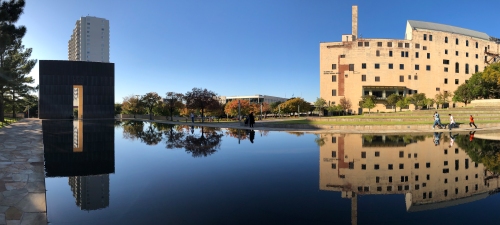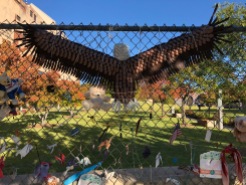Traveling West on Old Route 66
10/13/19
Driving from Birmingham to Little Rock, AR we encountered a warm, green landscape of forests and rolling hills called the Boston Mountains. I had forgotten how beautiful the South was and this area really impressed me. We drove from northern Alabama to northeastern Mississippi through the beautifully named town of Tupelo. This was part of the South that neither of us had seen and it was fascinating. As we drove through Memphis I waved in the direction of Graceland and vowed to come back and spend more time. At Little Rock we finally got on Interstate 40 which was the old Route 66. Besides the song and the TV show, Route 66 was the road West for many of the Dust Bowl migrants in the 1930s. The fictional Joad family in Steinbeck’s The Grapes of Wrath followed this road all the way to the Promised Land of California and so will we.
10/14/19
The next day we followed this Mother Road through the drier rolling hills of the many Indian Nations of eastern Oklahoma. This area describes itself as Native America for a reason. In the early 19th century our country had a process of forcibly removing the Native Americans from their land in the South and sending them to eastern Oklahoma. This eventually led to the infamous Trail of Tears that is now recognized as a crime against the humanity of the Native People. Many of their descendants still live here, even after the State of Oklahoma was opened up to white settlement in the latter part of the 19th century. The Indigenous people were continuing the process of reclaiming their heritage and identity and we saw many Native American license plates on the cars of different tribes of this area. I remember seeing the struggles of the Indigenous people in Canada and realized that this will be a long process of healing.
We pulled into Oklahoma City in a beautiful late afternoon light and headed straight to the Oklahoma City National Memorial and Museum. Here was the site of the famous Oklahoma City bombing in 1995 by two white nationalist, nut-jobs Timothy McVeigh and Terry Nichols. One hundred and sixty-eight people died here and six hundred and eighty were injured. It remains the deadliest incident of domestic terrorism in the US. On one side of the Memorial was a field of symbolic bronze and stone chairs – one for each person lost. The chairs represent the empty chairs at the dinner tables of the victims’ families. A chain link fence which had surrounded the site of the blast had attracted over 800,000 personal items of commemoration. Part of the fence was still on display. Like the memorials we saw in Alabama, these symbols against hate were effective, gut-wrenching and important.



10/15/19
Today we drove through western Oklahoma and the Panhandle of Texas arriving nine hours later in Santa Fe, NM. Compared with the eastern part of the state, Western Oklahoma was flatter, drier and whiter. It still contained some of the rolling hills of the East, but we finally felt like we had entered the American West. The austerity and aridity of this land is so different from the Eastern US. After two months on the road we felt, in some ways, that we had come back home.
Podcasts and CDs were our constant companions. The news about our President was so bad that the intervals of music brought us great joy. But each time we went back to the news, things only seem to get worse. It is ironic to be traveling through a part of the country that so solidly supports Trump. When will they finally abandon him?
After another long-haul drive we arrived at the house of our old, dear friends Meridel and Jerry. She is a well-known and wonderful photographer who taught for many years in Singapore. She is currently working on a long-term environmental photographic project in Iraq. Jerry comes from an old New Mexican ranching family and is a brilliant painter. He has worked most of his life as a contractor.
They used to be married but are still good friends and live next to each other. Meridel’s partner Ben has been an Oscar-winning documentary film maker and is about to start teaching for one year at a university in Sweden.
This was the rich mix of accomplished people that we were staying with for one full day. We greatly enjoyed just staying still in the glorious desert. We were like wide-eyed, shell-shocked children as we wandered through a near-by arroyo secco.
We also enjoyed watching the three-hour Democratic over Vietnamese take-out. We all spent the evening trying to figure out who among the twelve people on stage will be our next President.

10/16/19
Santa Fe to Flagstaff, AZ was another back-aching, bun-busting long drive. Fortunately, the wide-open spaces were awe inspiring. It even seemed appropriate to hear a Terry Gross interview on singing cowboys. Peanut butter and hot sauce was was our essential road food.

A massive forest fire obliterated the famously blue skies as we approached Flagstaff. We had read about the recent disastrous fires in this region and in Southern California. It is another sickening result of climate change inaction by the Republican climate change deniers in Washington. Smoke clung to the air as we entered the forests of Flagstaff. As the American West was again burning, we saw one more reason why the next election is so crucial.

10/17/19
Our second-to-last day of this epic journey took us from Flagstaff to Bakersfield, CA. The beautiful Arizona forests turned into a drier, hotter desert as we descended to the Colorado River.

We crossed into California at the small town of Needles. I tried to imagine what it must have been like for the Dust Bowl refugees of the 1930s as they entered what they believed to be the Promised Land.
We zip through the great, dry desert and we rise up to a high plateau on the southern edge of the Mojave National Preserve. I know and love this area well having taught workshops in the Park for over ten years at a great little place called Zzyzx. Halfway between Barstow and the desert town of Mojave was a small intersection called Kramer’s Junction. We stopped to get gas and found ourselves in the middle of a giant sandstorm. The force of nature was both frightening and awe-inspiring.

Crossing over the Tehachapi Mountains we were struck by the ethereal light of the clouds and sky and also the vastness entering the San Joaquin Valley.

I have spent so much time working on projects in this area that I felt I was entering home. Bakersfield is a tragic, poetic and fascinating place. It has some of the worst air-quality in the country and yet has also produced some great writers and a unique form of country western music called the Bakersfield Sound. I always think of Merle Haggard and Buck Owens when I drive through here. I was amazed to hear on the local public radio station some guy who had organized a pro-Trump rally here complaining about all the people driving by flipping him off. With what has been going on, what was he expecting even here in conservative Bakersfield?
10/18/19
We discovered an oil-derrick themed hipster coffee shop in downtown Bakersfield. It was excellent and gave me hope for the revival of the downtown.
The five-hour drive to San Francisco gave us time to think and talk about the big take-aways from our two-moth journey around the edges of our country. Three new ideas emerged from this journey. The first was the relationship between the Indigenous people of Canada and education. Sadly, we found that some of those efforts were misguided. I had always felt that education could be a great tool to help lift people out of poverty and elevate their lives. We found, in some cases, education could also become a form of cultural genocide for the Native people.
The second big take-away occurred in Québec. We saw many churches in the province that had gradually lost their parishioners and had been abandoned. Ironically, several of these churches had become public libraries. Why the loss of faith? What caused the people of Québec to abandon their once dominant religion? Why were secular public libraries occupying what was once a religious space? What does all this say about the sacred and the secular in contemporary French-Canadian society?
Finally, the last take-away occurred in the South. Here we traced the epic struggle for Civil Rights, especially in Alabama. I was fascinated by the role that libraries played in that struggle. I was encouraged to see that libraries continued their role not only as community centers but, for some communities, as a place to heal a broken civic space. This idea deserves a lot more research and I will be coming back to explore this more in the future.
It was with great joy that we finally came to a stop at our home in San Francisco. We had traveled almost 11,000 miles circumnavigating the country. We will now stay still for a while and absorb the many lessons we have learned. Thanks for coming along for the ride! Between this trip and the Fulbright Fellowship, we have been on the road for eight out of the last fourteen months. Time for a break and I will be back in touch.
Until then…













































































